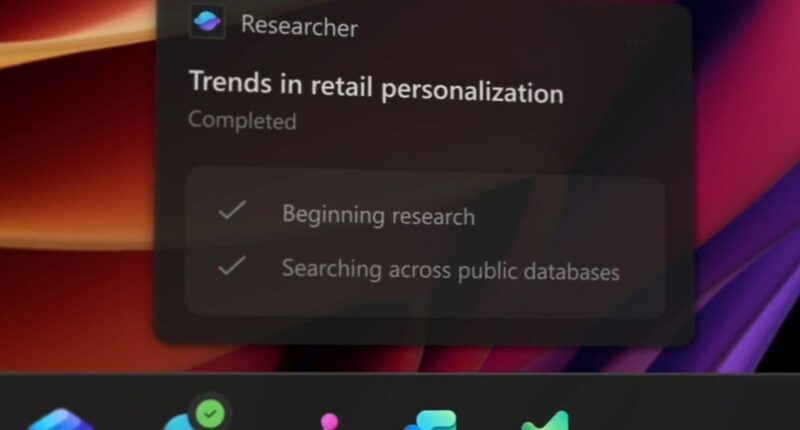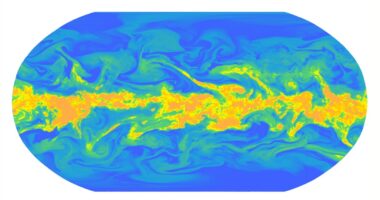Share this @internewscast.com
In an ambitious shift, Microsoft is redefining Windows as a “canvas for AI” by embedding sophisticated AI agents directly into the Windows 11 taskbar. These enhancements aim to transform the taskbar into a virtual assistant that seamlessly manages tasks on your behalf with just a single click. This initiative is part of a larger strategy to evolve Windows into what Microsoft terms an “agentic OS.”
Navjot Virk, the corporate vice president overseeing Windows experiences, emphasized the goal: “Our objective is to empower every user with AI’s superpowers,” she stated during a conversation with The Verge.
The company is incorporating a suite of AI agents, including its proprietary Microsoft 365 Copilot alongside third-party options, within the Windows 11 taskbar. “This isn’t merely about adding AI agents; it’s about integrating them into the core operating system experience,” noted Windows chief Pavan Davuluri.

These agents are designed to multitask efficiently, like gathering data in the background while you focus on other activities, or accessing files on your device to automate tedious administrative duties. Once activated, an AI agent will operate from the taskbar, functioning quietly in the background. “You can simply hover over the taskbar icon at any moment to check the agent’s progress,” Virk elaborated.
This integration introduces the Ask Copilot feature in the taskbar, which merges local file search with Copilot’s advanced capabilities. “Beyond rapid file and settings searches, users can now engage in dialogue with Microsoft 365 Copilot and launch AI agents directly from the taskbar,” Virk explained.
To enhance usability, Microsoft has upgraded taskbar features, allowing users to easily monitor the status of tasks being handled in the background. A floating window facilitates interaction with both the agents and Microsoft 365 Copilot, eliminating the need for a full application interface.

If an agent needs attention or completes a task, it will notify you and update its state on the taskbar. There are badges on the AI agent taskbar icons that show you visually that an agent is progressing with a task: a yellow exclamation point when it needs help, or a green tick for when it has completed something.
If you don’t want AI agents on the taskbar, you don’t have to enable this feature. “These experiences are designed to be opt-in, we want customers to have full control over when and how they engage with Copilot and these agents,” says Virk.
Developers will ultimately think up a lot of use cases for these agents, and Microsoft is doing a lot of the platform-level work to make them possible. AI agent capabilities are being embedded into core parts of Windows thanks to Model Context Protocol (MCP). “Essentially what they do is give us a standardized framework that allows these agents to discover tools and discover other agents through a secure managed on-device registry,” says Davuluri. “It also gives us, the Windows team, the ability to provide tools in an agentic framework for these agents to go and consume.”
AI agents will also have their own workspace, separate to your Windows 11 desktop. “It’s a contained policy-controlled auditable execution environment,” says Davuluri. “It gives us a place where the agents can operate with software in an analogous fashion to what people do.” Agent workspace is like a sandbox for AI agents, where each agent operates using its own Windows account. This is all in the name of security, and probably because AI models aren’t always accurate so you’ll want that activity separate to your main Windows session.
While agents in the taskbar is a big new AI addition to Windows 11, it’s not the only way Microsoft is reimagining the operating system into what it calls an “agentic OS.” Microsoft is also bringing Copilot into File Explorer as part of this work. “What we want to do is make it even more convenient to get highly contextual and deeper Copilot help in Windows surfaces that you already use a lot, like the File Explorer,” says Virk.
Copilot integration in File Explorer lets Windows 11 users summarize a document in one click, answer questions about files, or draft emails based on the content of a document.

Click to Do is also being improved on Copilot Plus PCs, allowing you to convert any table you see on the web or anywhere else on your PC into an Excel document. You can then freely manipulate the data and add new columns. While Click To Do uses local AI models on a Copilot Plus PC, once that data is in Excel you can modify it using cloud-powered AI models through Copilot and Agent Mode.
This hybrid mix of local AI (Copilot Plus PC) and cloud-powered AI (Copilot) seems to be where Microsoft is heading with its Windows AI features. A new writing assistance feature is entering preview that lets you rewrite and compose in any text box in Windows 11, and it even has offline support on Copilot Plus PCs.
Outlook is also getting AI-generated summaries, and Word is getting automatic alt-text for images in Office documents. Microsoft is also working on a new “fluid dictation” feature for Windows that turns speech into text with correct grammar and punctuation.
This hybrid mix of AI is even more apparent in Microsoft’s Windows 365 service. These cloud PCs — that can be accessed through Windows 11, a web browser, or mobile apps — include Copilot Plus features and also have access to the main cloud-powered Copilot features.
If you’re not interested in the AI additions to Windows, Microsoft also has some IT-focused additions at its Ignite conference this week. Hardware-accelerated BitLocker is on the way next year, and will require next-generation Windows devices that are built on unannounced chips. “Hardware acceleration of BitLock requires the capability in the silicon platform,” says Davuluri. “As and when those capabilities are available, the OS will be able to unlock them for users.”
Sysmon functionality is also being integrated into Windows in early 2026. It will make security events available in the event log and make it easier for security teams to manage Windows systems. Microsoft is also launching Windows Hello’s visual refresh and new passkey manager integration, which works with Microsoft Password Manager in Edge, 1Password, and Bitwarden.








